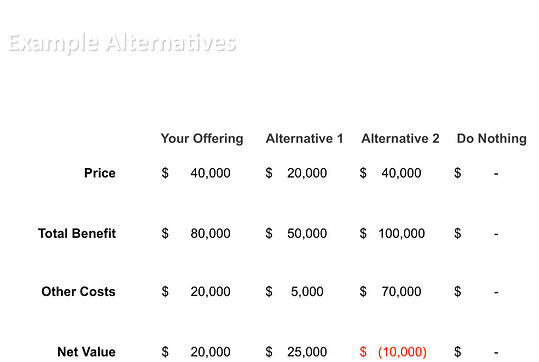
This is Part IV of a five-part series about the value lifecycle in B2B selling and marketing. This post explores Phase 3: Differentiating from your competition.
So far we've learned two important points about the value life-cycle.
1) In Phase 1, the maximum price you can charge for your product/solution is the value you create minus the value of the next best alternative, plus the price of the next best alternative.
2) In Phase 2, your job is to show not only how much the customer’s problems are costing them (both in terms of actual cost but also lost revenue), but also how much your solution can help them overcome that cost.
After you've established your price and gotten the prospect concerned about their business challenges, it’s time to turn your attention to Phase 3: differentiating against your competition. Obviously, this issue tends to be a popular topic with sellers and marketers. Everyone wants to win. However, the reality is that not every product or solution has the right level of value to be a worthwhile investment for prospects. (The good news is that a thorough analysis can uncover those gaps and you can then work on a way to create more value.)
In this phase of the Value Lifecycle, you are showing that the total value your solution creates is higher than the total value created by the next-best alternative (aka, a competitor). This is often referred to as TCO, or Total Cost of Ownership. A formal TCO analysis is a very effective and airtight way to show your value versus the competition’s value, and it takes into account the features and benefits of your solution. Unfortunately, features, functions, and benefits are where the conversation starts and ends for a lot of sales and marketing professionals.
Features and benefits are all well and good, but they don’t tell the whole story (and sometimes they actually tell a false story, as you’ll see below). When you’re in a competitive situation, you’re not just talking about the things you do well, or that you’re priced 10 percent lower than the competition, or that you have bells and whistles that your competitor lacks. You want to engage the customer in a discussion about the relative value you create compared to a competitive offering. Your net value needs to be higher than that of the competition, and it needs to include more than your price and/or the cost required to deploy and maintain your solution. It must reflect an analysis of the total value you create, which would include price, cost to deploy and maintain, reduced costs in other areas, and even increases in revenue..
This chart illustrates the point.

Let’s say you create $20,000 of net value and your competitor (Alternative 1) is creating $25,000. That probably doesn't make you very happy. But as we pointed out in Phase 1, value is always specific to each customer. In other words, if your offering comes up short, you can try to adjust to suit this particular prospect. If you lower your price so that you create $30,000 in net value, for example, then you create more value and can convince the prospect to buy from you versus Alternative 1. If you didn't want to lower your price, you could add to the Total Benefit category instead -- going from $80,000 to $100,000 would help you create $40,000 in net value. Another option would be to lower deployment and maintenance so that costs fall below $20,000.
No matter what you do, remember that a good TCO analysis always takes into account all possible factors: price, benefits, and cost. As you can see from this example, if you stopped evaluating purchasing options at benefits, then Alternative 2 would look like the clear winner (when, in fact, it provides the least value to the prospect).
There are only two things you can’t do. One is to remain ignorant of the total value you create. If you’re in sales or marketing, it’s simply part of your job to know your total value, and also to know how that value compares to a competitor’s value. The second thing you can’t do is tweak your messaging to try to get around the fact that your competitor creates more value than you. If that’s the case, you’re essentially lying to customers and adding to the perception that marketers and sellers are just trying to make a sale at any cost. Your job is never to convince customers to buy independent of the truth.
Next week we’ll dive into the final phase of the Value Lifecycle: justifying the cost of your investment.








